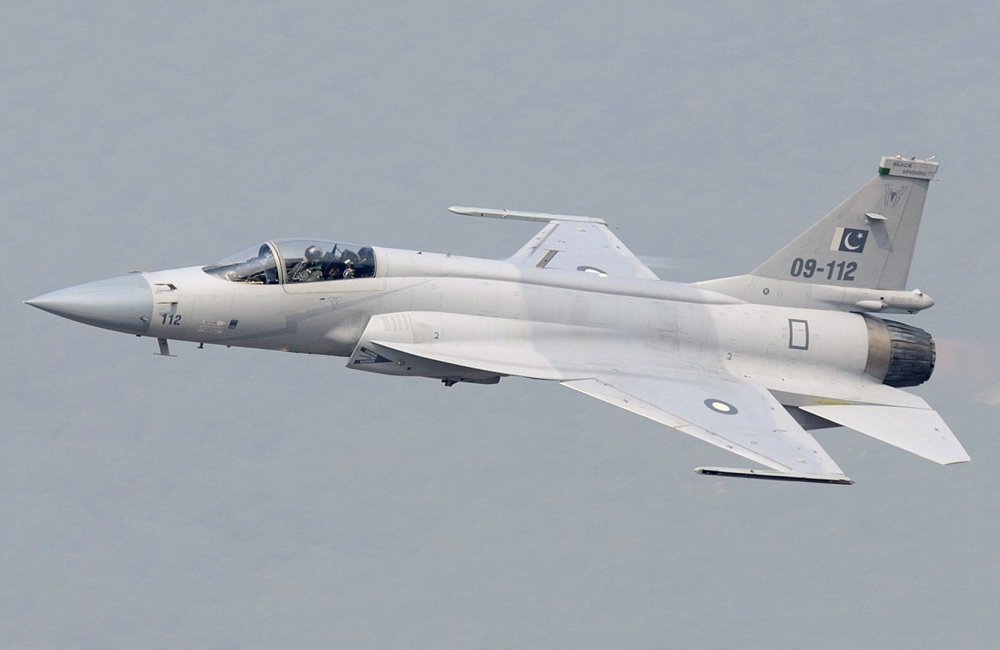space cadet
SENIOR MEMBER

November 23, 2019 Topic: Security Blog Brand: The Buzz Tags: PakistanUnited StatesMiGJF-17Jets
Can't Get an F-35? Could Pakistan's JF-17 Be the Next Great Fighter Jet?
It's a capable jet.
by Sebastien Roblin
Key point: The JF-17 lacks stealth.
In the 2019 Paris Air Show, Pakistan its lightweight JF-17 Thunder jet fighter it began building a decade ago in conjunction with China. You can see the seven-ton fighter performing maneuvers in this video.
Just a few months earlier, Pakistan dispatched what it claimed to be twenty-five JF-17s to launch a lightning strike across the Line of Control on targets in Kashmir, in retaliation for an Indian air raid on a JeM terrorist training camp.
The PAF claimed its JF-17s had shot down two Indian fighters pursuing strike planes into Pakistani airspace. However, while the loss of one upgraded Indian MiG-21 Bison was confirmed and its pilot captured, India subsequently displayed fragments of American-made AIM-120 missiles only compatible with Pakistan’s F-16s, casting some doubt on whether the PAF’s Thunders were responsible for the kill.
Pakistan currently operate around 100 Thunders in five operational squadrons, plus a testing and training unit. The first Thunders entered squadron service in 2010 and saw action bombing insurgents in Waziristan. Islamabad also confirmed in 2018 a $184 million deal to sell three JF-17s to the Nigerian Air Force in 2018 (which currently operates J-7s and Alpha Jets), and has delivered at least six out of an order of eighteen
The PAF now plans to procure fifty more JF-17s of an improved Block III standard by 2024—with airframes produced jointly by Pakistan and China in a 58/42 percent split—as well as procure 26 two-seat JF-17Bs with additional fuel stored in a dorsal fin and enhanced application to training and possibly strike missions. Extant JF-17s may also be upgraded to the Block III variant, which should make its first flight later in 2019.
F-16 Meets MiG-21—in China
Islamabad and Beijing have been close allies since the 1950s, finding in India a common adversary during the Cold War. Pakistan also nurtured warm ties with the United States, but these waned in the twenty-first century due to its intelligence services enduring ties to Islamist terrorist organizations.
One facet of these tensions is that the Pakistani Air Force has only sporadically been able to purchase additional F-16s to reinforce the dozens it acquired during the 1980s that saw a surprising amount of action battling Soviet jets over the Pakistan/Afghan border.
Thus, as early as the 1990s, Pakistan turned to China for an F-16 alternative to replace its aging Chinese-built J-7 and A-6 fighters, themselves Chinese clones of the Soviet MiG-21 and MiG-19.
During a period of increasing defense cooperation with the United States in the 1980s, China had actually pursued a joint venture with Grumman to build an upgraded J-7 fighter called the Super-7 or Sabre II, using avionics from the F-16. This and other project fell through after the Tiananmen Square massacre in June 1989 permanently chilled U.S.-China defense cooperation.
But the Chengdu Aircraft Corporation kept on working on the Super-7 project, and in the 1990s offered to jointly develop an affordable F-16 substitute based upon the Super-7 called the JF-17 Thunder with the Pakistan Aeronautical Complex. PAC had formerly principally been involved in re-building old J-7s and Mirages.
The Thunder, which first flew in 2003, is a no-nonsense evolution of the MiG-21. Instead of the MiG-21’s R-25 turbojet with a nose intake, the Thunder uses an RD-93 turbofan (a variant of the RD-33 on the MiG-29 Fulcrum) with lower fuselage intakes. The JF-17’s maximum speed of Mach 1.6 to 1.8 leaves it marginally slower than its Soviet forebearer, but the Thunder remains highly maneuverable, has a superior range of around 750 miles, and its KLJ-7 doppler radar is far more powerful.
Of course, in contrast to the F-16, the JF-17 is designed to employ Chinese weapons on its seven hardpoints, including the PL-5 short-range air-to-air missile, LS-6 ‘Thunderstone’ GPS-guided glide bombs, and YJ-12 supersonic and YJ-83 subsonic anti-shipping missiles. (The PAF’s No.2 squadron maintains one squadron in the maritime strike role.) The PAF JF-17s are still awaiting Chinese PL-12 radar-guided missiles with a range of around fifty miles to obtain true beyond-visual range capability.
Though not directly integrated, the JF-17 can also carry electro-optical/infrared sensors and self-defense jammers on external pods.
While early JF-17 models priced out to a cheap $15-28 million—cutting edge jets fourth and fifth-generation jets tend to cost $70-110 million)—the Thunders lacked certain basic capabilities. For example, aerial-refueling capability was not introduced until the Block II model.
The new Block III, which will supposedly cost around $32 million each, now introduces a helmet-mounted display system which should allow more flexible targeting of short-range missiles in close dogfights. The jet intakes are widened to improve airflow, and the Russian RD-93 engine may eventually be replaced by a Chinese manufactured WS-13 turbofan. Additional thrust, combined with lightweight composite materials could potentially boost the type’s speed and range.
Perhaps the most important upgrade is an upgrade of the radar to an Active Electronically Scanned Array (AESA) radar. These have higher resolution, are more discrete and are more jam-resistant than preceding classes of radar. PAC is evaluating a KLJ-7A radar with a wider-angle search field and a detection range of 124 miles for fighter-sized target, and an air-cooled LKF-601E AESA radar.
The Block III Thunder may also feature an internal infrared sensor and modernized flight control systems and a single-panel multi-functional display for the pilot.
While the Thunder is not particularly sexy compared to cutting-edge stealth fighters and even 4.5-generation jets like the Rafale and Su-35, its seems capable for its price, particularly once it integrates AESA radar and the PL-10 missile. It seems likely to show up in the new again if there any future showdowns between Pakistani and Indian aviation.
Last edited by a moderator:

